Table of Contents
STARS AND STARGAZING
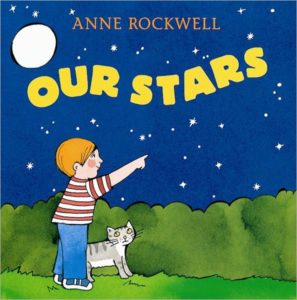 |
Anne Rockwell’s Our Stars (Houghton Mifflin Harcourt, 2002) has bright pictures and a short simple text for ages 3-6. |
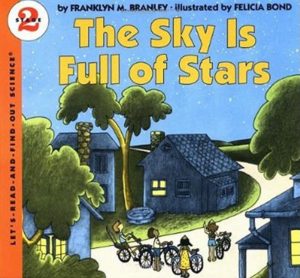 |
In the Let’s-Read-and-Find-Out Science series, Franklyn Branley’s The Sky Is Full of Stars (HarperCollins, 1983) is a simple introduction to stars and stargazing for ages 4-8. |
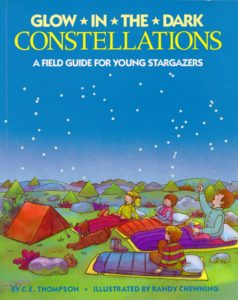 |
C.E. Thompson’s Glow-in-the-Dark Constellations (Grosset & Dunlap, 1999) is a straightforward introduction to ten major constellations, each given a double-page spread. (And they glow in the dark.) For ages 4-8. |
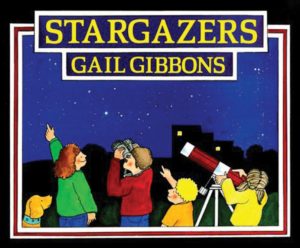
|
By Gail Gibbons, The Stargazers (Holiday House, 1999), illustrated with bright attractive drawings, covers stargazers, ancient and modern, stars and constellations, and the operation of telescopes and planetariums. A straightforward introduction for ages 5-8. |
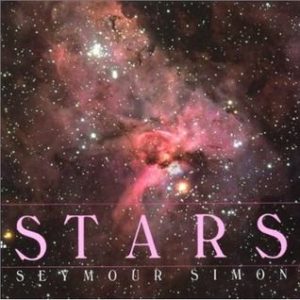 |
Seymour Simon’s Stars HarperCollins, 2006) and Galaxies (HarperCollins, 1991) are excellent introductions, illustrated with spectacular full-page color photographs. For ages 6-10. |
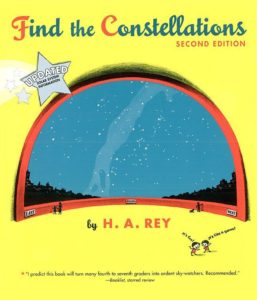
|
Looking up, of course, is easy; the trick is to know just what you’re looking up at. A wonderful help here is H.A. Rey’s 72-page Find the Constellations (Houghton Mifflin Books for Children, 2008) – an excellent (and classic) beginner’s guide to the stars for ages 5-11. |
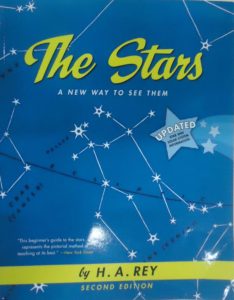 |
For older kids, check out Rey’s The Stars: A New Way to See Them (Houghton Mifflin Books for Children, 2008), 160 pages of beautifully presented information, diagrams, drawings, and star maps. For ages 12 and up. |
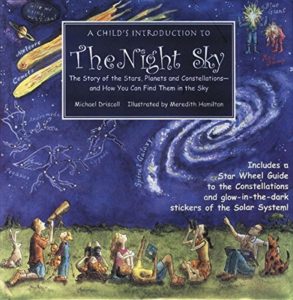
|
A Child’s Introduction to the Night Sky by Michael Driscoll (Black Dog & Leventhal, 2004), illustrated with photos, diagrams, and colorful cartoon drawings, is divided into two main sections: “What’s Up There?” (including “What We Can See” and “What We Can’t See”) and “Exploring What’s Up There,” which provides guidelines for sky viewing through the four seasons of the year. For ages 8 and up. |
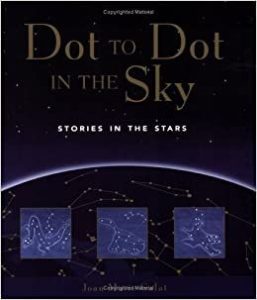
|
Joan Marie Galat’s Dot to Dot in the Sky: Stories in the Stars (Whitecap Books, 2010) has scientific facts and a mythological story for each of fifteen prominent constellations. A star chart and “dot-to-dot” patterns help beginners locate them in the sky, For ages 8-12. |
| Also by Galat in the same Dot to Dot in the Sky series are Stories of the Planets, Stories of the Zodiac, and Stories of the Moon. | |
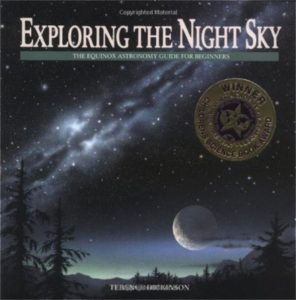
|
Terence Dickinson’s Exploring the Night Sky (Firefly Books, 1987) is an excellent star-spotting resource, featuring a “Cosmic Voyage” in “40 jumps” from the neighborly Moon to distant galaxies; an overview of the solar system and deep space; and a stargazing guide. For ages 10 and up.Also see Dickinson’s Night Watch (Firefly Books, 2006), which includes stargazing guides for the naked eye, binoculars, or small telescopes, plus a great series of star charts. |

|
Fran Lee’s Wishing on a Star: Constellation Stories and Stargazing Activities for Kids (Gibbs Smith, 2001) shows kids how to make a “twinkling thaumatrope” (a Victorian spinning toy), a star-patterned kite, and a star mobile, and includes script and instructions for performing a constellation myth play. |
| The barebones stargazer doesn’t need more than a star map, a red-cellophane-covered flashlight for peeking at it (red light won’t interfere with your night vision), and a comfy blanket. A wonderful extra, however, is a green laser pointer. These are much brighter than the red versions, and the green beam dot shows up in midair, which means that it can be used for pointing at stars and constellations (“skypointing”). | |
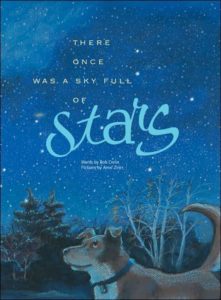 |
Bob Crelin’s picture-book There Once Was a Sky Full of Stars (Sky Publishing, 2007), in simple rhyming text, describes the wonders of the night sky and their loss due to light pollution. For more information, visit the International Dark Sky Association. |
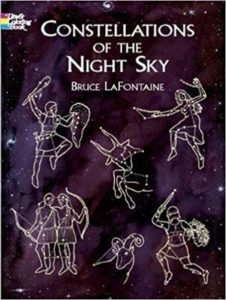 |
Bruce LaFontaine’s Constellations of the Night Sky (Dover, 2003) is a 48-page informational coloring book. |
| Enchanted Learning has a large collection of printable constellation connect-the-dot puzzles. | |
| Donna Young’s Pringles Can Viewer and Constellation Slides has printable constellation slides and instructions. | |
| For the ambitious, see How to Build an LED Plantetarium. | |
| Make Your Own Tin Can Pinhole Planetarium has illustrated instructions. | |
| This Shoebox Planetarium Project has complete instructions – suggested as a group project for learning constellations. | |
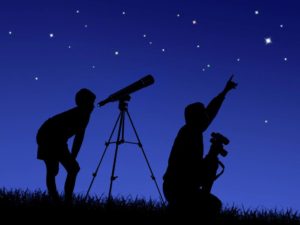 |
Skymaps offers free printable monthly sky maps (both northern and southern hemispheres) and a monthly sky calendar of best objects to see with binoculars, telescope, or naked eye. |
| Amazing Space has a gallery of Hubble images, “Tonight’s Sky,” a guide to currently viewable constellations and other night-sky objects, and a long list of terrific interactive explorations for kids on galaxies, comets, black holes, the solar system, and more. | |
| From NASA’s Space Place, Make a Star Finder has instructions and printable star-map patterns for each month of the year. | |
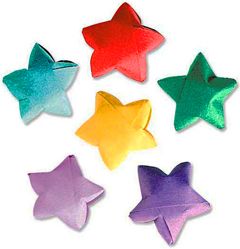 |
See these instructions for making origami dream stars. |
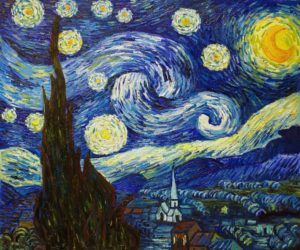 |
From the Van Gogh Gallery, learn about and view Van Gogh’s Starry Night and other starry paintings. (Try painting one of your own.) |
STAR STORIES
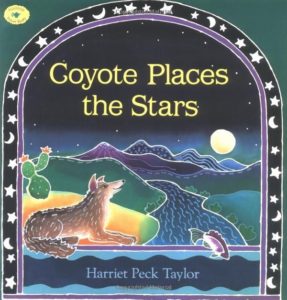
|
Harriet Peck Taylor’s Coyote Places the Stars (Aladdin, 1997) is a picture-book tale of the irrepressible Coyote who climbs a ladder to the moon and there makes wonderful animal pictures in the sky by shooting arrows at the stars. For ages 4-8. |
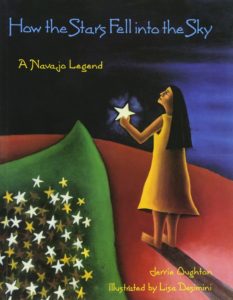 |
Jerrie Oughton’s How the Stars Fell Into the Sky (Sandpiper, 1996) is a Navajo legend about the origin of the stars and constellations. First Woman is making a careful pattern – a “careful mosaic on the blackberry cloth of night” – until impatient Coyote decides to help. For ages 4-8. |
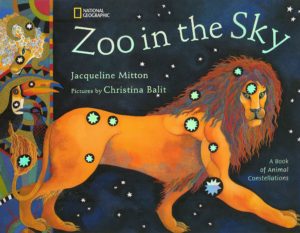
|
Jacqueline Mitton’s Zoo in the Sky: A Book of Animal Constellations (National Geographic Children’s Books, 2006) pairs animal legends and a bit of scientific information with gorgeous silver-star-studded paintings by Christina Balit. For ages 5-9. |
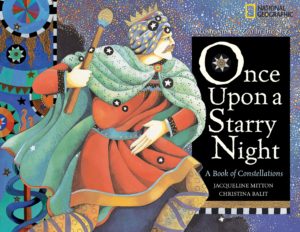
|
Also by Jacqueline Mitton and Christina Balit, see Once Upon a Starry Night (National Geographic Children’s Books, 2009) for star stories from Greek myths; and Zodiac: Celestial Circle of the Sun (Frances Lincoln Children’s Books, 2008), for science, history, and legends of the twelve constellations of the Zodiac. For ages 5-9. |
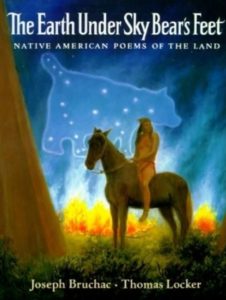 |
Joseph Bruchac’s The Earth Under Sky Bear’s Feet (Putnam Juvenile, 1998) is a collection of poems based on tribal legends of the Sky Bear (Big Dipper), illustrated with oil paintings. For ages 6-12. |
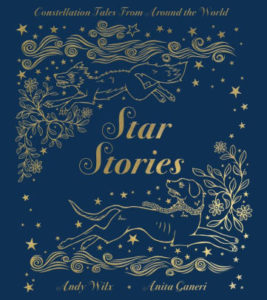 |
Anita Ganeri’s Star Stories (Running Press, 2019) is a beautifully illustrated collection of myths about sun, stars, and Milky Way from cultures worldwide. For ages 8-12. |
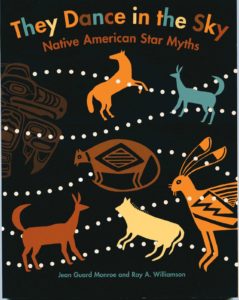 |
They Dance in the Sky by Jean Guard Monroe and Ray A. Williamson (Sandpiper, 2007) is a 144-page collection of star myths from a wide range of Native American tribes, among them Navajo, Pawnee, Micmac, Tlingit, and Mohawk. For ages 9 and up. |
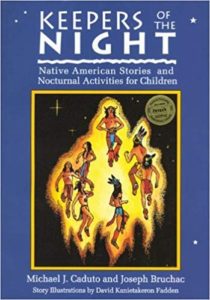 |
Keepers of the Night by Michael J. Caduto and Joseph Bruchac (Fulcrum Publishing, 1994) pairs native American star legends with activities, games, and science and nature experiments. |
